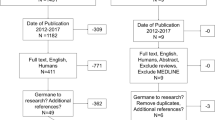Abstract
Health Level Seven (HL7) organization published the Clinical Document Architecture (CDA) for exchanging documents among heterogeneous systems and improving medical quality based on the design method in CDA. In practice, although the HL7 organization tried to make medical messages exchangeable, it is still hard to exchange medical messages. There are many issues when two hospitals want to exchange clinical documents, such as patient privacy, network security, budget, and the strategies of the hospital. In this article, we propose a method for the exchange and sharing of clinical documents in an offline model based on the CDA—the Portable CDA. This allows the physician to retrieve the patient’s medical record stored in a portal device, but not through the Internet in real time. The security and privacy of CDA data will also be considered.








Similar content being viewed by others
Reference
Yu, W. D., Chekhanovskiy, M. A., An electronic health record content protection system using smart card and PRM™. In Proceedings of the 9th International Conference on e-Health Networking, Application and Services, (pp. 11–18), 2007.
McGuire, M.R.: Incorporating an EPR system with a universal patient record. J. Med. Syst. 30, 259–267 (2006). doi:10.1007/s10916-005-9007-7
Maglogiannis, I., Delakouridis, C., Kazatzopoulos, L.: Enabling collaborative medical diagnosis over the internet via peer-to-peer distribution of electronic health records. J. Med. Syst. 30, 107–116 (2006). doi:10.1007/s10916-005-7984-1
Dolin, R.H., Alschuler, L., Boyer, S., Beebe, C., Behlen, F.M., Biron, P.V., Shabo, A.: HL7 Clinical document architecture, Release 2. J. Am. Med. Inform. Assoc. 13(1), 30–39 (2006). doi:10.1197/jamia.M1888
Extensible Markup Language (XML) 1.0 (Second Edition) W3C Recommendation 6 October 2000. Available from: http://www.w3.org/TR/2000/REC-xml-20001006
Marcheschi, P., Mazzarisi, A., Dalmiani, S., Benassi, A., New standards for cardiology report and data communication: an experience with HL7 CDA release 2 and EbXML. Comput. Cardiol. 383–386, 2005. doi:10.1109/CIC.2005.1588117
Bilykh, I., Jahnke, J. H., McCallum, G., Price, M., Using the clinical document architecture as open data exchange format for interfacing EMRs with clinical decision support systems. In Proceedings of the 19th IEEE Symposium on Computer-Based Medical Systems, (pp. 855–860), 2006.
Kim, H. S., Tran, T., Cho, H., A Clinical Document Architecture (CDA) to generate clinical documents within a hospital information system for E-Healthcare services. In Proceedings of the 6th IEEE International Conference on Computer and Information Technology, (pp. 254–254). 2006.
Chan, A.T.S., Cao, J., Chan, H., Young, G.: A web-enabled framework for smart card application in health services. Commun. ACM. 44(9), 77–82 (2001). doi:10.1145/383694.383710
Kardaas, G., Tunali, E.T.: Design and implementation of a smart card based healthcare information system. Comput. Methods Programs Biomed. 81, 66–78 (2006)
Health Level Seven, Inc., HL7 V3 Guide. HL7 Version 3 Interoperability Standards, Normative Edition, 2006.
SNOMED Clinical Terms, College of American pathologists.: Available from: http://www.snomed.org/. Accessed Jan 2007.
Logical Observation Identifiers Names and Codes (LOINC): Available from: http://www.loinc.org/. Accessed Jan 2007.
Win, K.T., Susilo, W., Mu, Y.: Personal health record systems and their security protection. J. Med. Syst. 30, 309–315 (2006). doi:10.1007/s10916-006-9019-y
Gritzalis, D., Lambrinoudakis, C.: A security architecture for interconnecting health information systems. Int. J. Med. Inform. 73, 305–309 (2004). doi:10.1016/j.ijmedinf.2003.12.011
Win, K.T.: A review of security of electronic health records. Health Inf. Manage. J. 34(1), 13–18 (2005)
17 FIPS PUB 197, Advanced encryption standard. Federal Information Processing Standards Publications, US Dept. of Commerce/N.I.S.T., Nov. 2001.
Snyder, A. M., Weaver, A. C., The E-Logistics of securing distributed medical data. In Proceedings of the IEEE International Conference on Industrial Informatics, (pp. 207–216), 2003.
Adams, C., Lloyd, S., Understanding the public-key infrastructure: concepts, standards, and deployment considerations. New Riders, 1st edition 1999.
Zoreda, J.L., Oton, J.M.: Smart cards. Artech House, Norwood, MA (1994)
Transformations, X. S. L., (XSLT) Version 1.0 W3C Recommendation 16 November 1999. Available from: http://www.w3.org/TR/xslt. Accessed Jan 2007.
ASTM WK4363 Draft Standard Specification for the Continuity of Care Record: Version 1. ASTM International, 2004.
Ferranti, J. M., Musser, R. C., Kawamoto, K., Hammmond, W. E., The clinical document architecture and the continuity of care record: a critical analysis. J. Am. Med. Inform. Assoc. 13(3), 2006. doi:10.1197/jamia.M1963
HL7 Continuity of Care Document: a Healthcare IT Interoperability Standard, is Approved. Available form: http://www.hl7.org/documentcenter/public/pressreleases/20070212.pdf. Accessed Jun 2007.
Author information
Authors and Affiliations
Corresponding author
Rights and permissions
About this article
Cite this article
Huang, KH., Hsieh, SH., Chang, YJ. et al. Application of Portable CDA for Secure Clinical-document Exchange. J Med Syst 34, 531–539 (2010). https://doi.org/10.1007/s10916-009-9266-9
Received:
Accepted:
Published:
Issue Date:
DOI: https://doi.org/10.1007/s10916-009-9266-9




